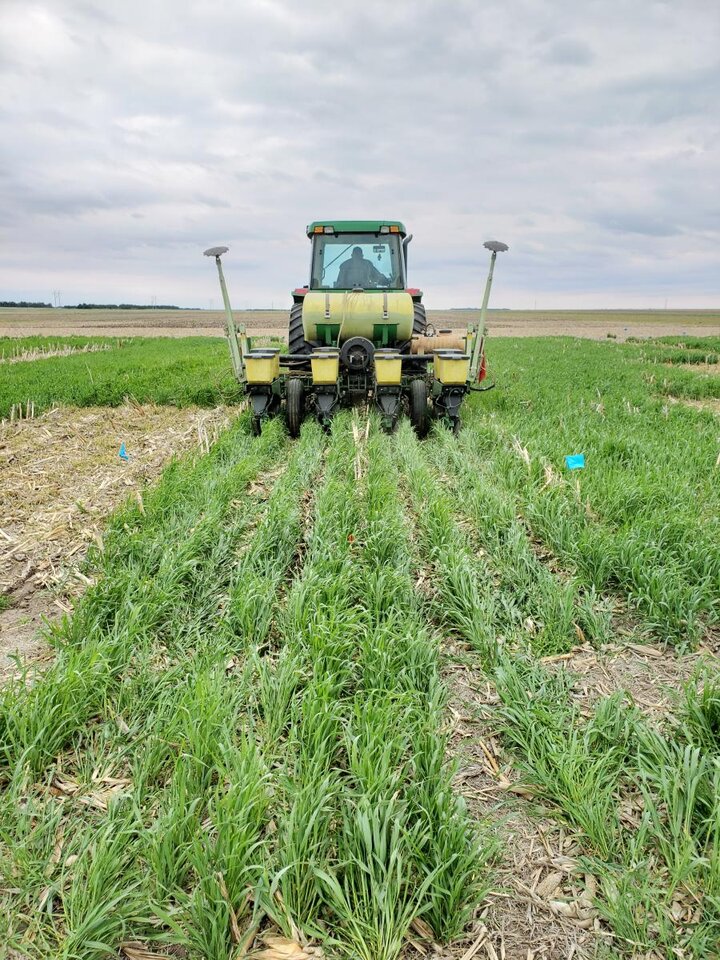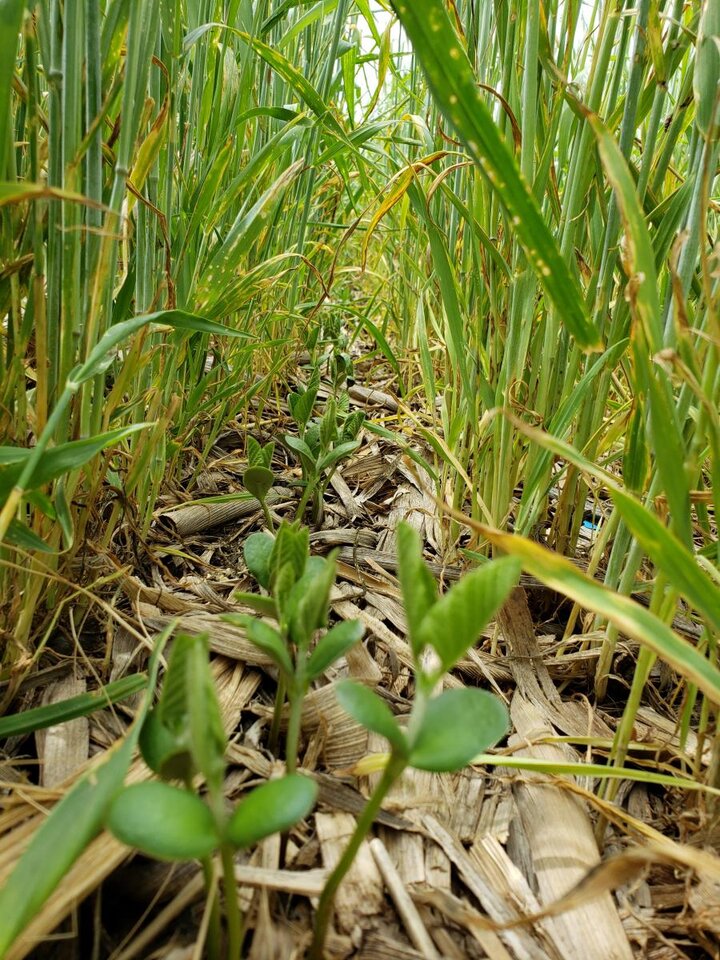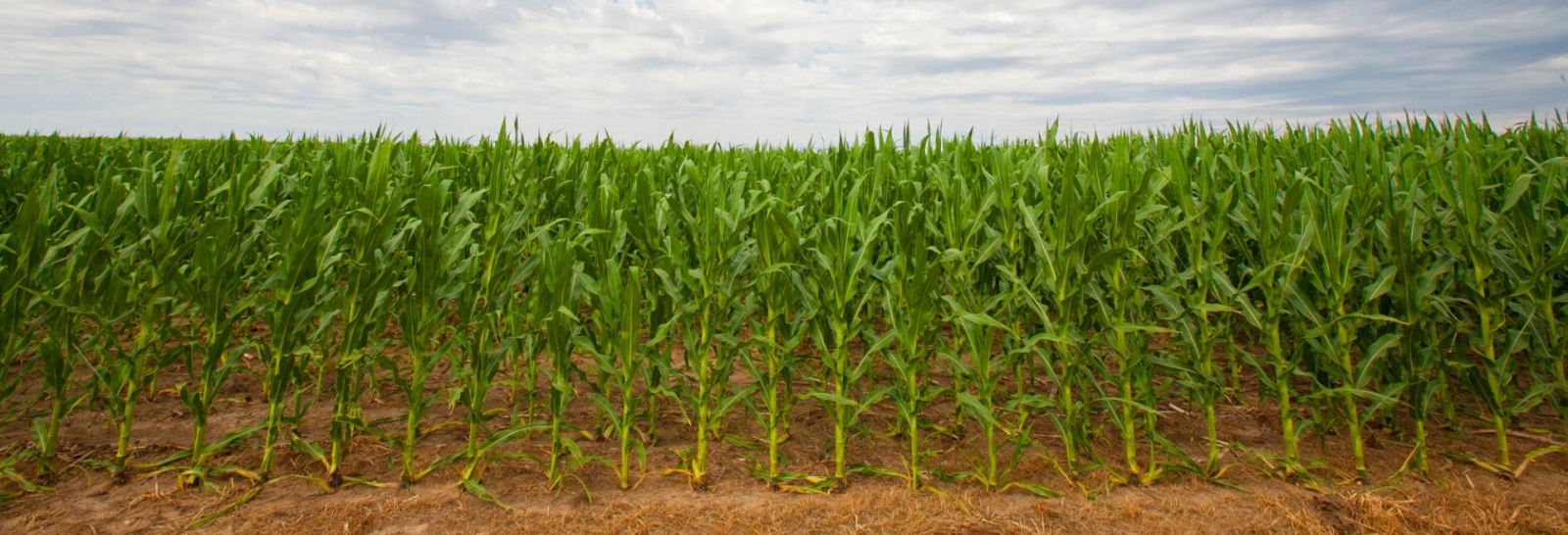A fall-planted cereal rye, wheat, or triticale cover crop can have both positive and negative impacts, for example by tying up nitrogen, reducing soil moisture prior to planting, increasing insect pressure, reducing weed pressure, reducing soil erosion and allelopathy.
Each year we receive questions on termination timing of cereal covers. This question occurs as farmers consider trade-offs between a positive return on investment from the cover crop, by allowing more biomass growth with the potential for yield loss if termination is delayed too long. Information being shared can be confusing, with one source saying to terminate pre-plant while another says to plant green into the cover.
What’s the “right” answer? We don’t know that there is one. That’s because farmers’ goals and level of risk vary. In general, there are less risks to planting green with soybean than corn. This article will share tradeoffs to help you better assess cover crop termination timing for your operation and risk level.

Cereal Rye and Potential Allelopathy
For several years, we’ve heard about the potential allelopathic effect cereal rye can have on corn. To avoid the potential allelopathic effects, it’s often recommended to terminate cereal rye at least two weeks before planting corn. Others report successfully planting corn into green cereal rye, leading to the question: Can allelopathic chemicals from rye affect corn?
We do know studies investigating the effects of allelopathic chemicals from cereal rye on corn germination have mostly been done in laboratory settings. One study found that allelopathic chemical extracts from rye reduced corn root length, but another study found no similar effects. We know there are allelopathic effects of rye on small seeds, but it's less certain this is the case with large seeds like corn and soybean. After working with growers since 2015 with rye cover crops, we feel nitrogen tie-up in the rye is the more likely cause for corn plants having any slower growth, yellowish color, or reduced germination. Growers who are concerned about potential allelopathy can increase the time between cover crop termination and corn planting.
Challenges with Terminating a Cereal Cover Pre-plant
The product used and the timing of termination pre-plant really depends on the producer's goals. If the grower is trying to conserve soil moisture or just isn't comfortable allowing the cereal cover to grow very tall, terminating it pre-plant is an option. Killing the cereal cover at least 14 days before planting may not allow for much growth in early spring or would require delayed corn planting, either way reducing the potential benefits from cover cropping. It's also important for the grower to have realistic expectations for how quickly the cover will completely die. Weather conditions are not always conducive for effective cereal cover termination. In early spring when temperatures are less than 55°F and cloudy conditions are common, herbicides such as glyphosate can have reduced absorption and translocation, resulting in delayed control. In contrast, glyphosate applied when weather is favorable can provide very effective termination of cereal rye while also providing early-season weed suppression.
Some growers may wish for the cereal cover to die more slowly so it remains longer to reduce soil erosion and for weed control. An option more growers are considering is to use clethodim instead of glyphosate when terminating a small grain prior to corn and/or seed corn planting. Clethodim kills cereals slower than glyphosate allowing for them to stay around longer between the rows, if those are part of the farmer's goals.
Benefits to Green Planting
Some farmers have shared the difficulty of planting through the partially decomposed “mushy” cover crop. Farmers also noticed corn planted into these conditions often came up slow and had a yellow, sickly look to it for a time. Farmers that switched to planting green say it was easier to plant compared with planting into the decomposing-dying cover and noted the corn also tended to look less yellow or sickly. Farmers have also shared the green standing rye held the previous crop residue in place and their corn emergence was more even in those fields compared to planting into terminated cover crop residue. Many have shared the observation of early-season weed suppression. Some have chosen to use planting soybean green into cereal rye for weed suppression and thus have removed the pre-plant herbicide from their system. One key for planting green is to not use residue removers as the rye can wrap, depending on the spacing and specific field conditions.
Risks to Planting Green

In spite of these observations, planting green is not for everyone and one needs to assess the risk of doing so. Cover crops use moisture and can dry out the seedbed. Some farmers in non-irrigated situations have planted corn/soybeans into dry seedbeds when planting green and hoped for rains. Some farmers have found the need to run pivots to get moisture into the seedbed. Thus, there’s greater risk for farmers with non-irrigated land and those in water allocation situations.
Another risk is the potential for increased insects. In 2017, wheat stem maggot was observed migrating from late-terminated cereal rye to emerging corn plants. We think it’s important to have insects in the back of one’s mind when planting green.
Research from Penn State and Wisconsin showed no yield difference when soybean was planted green vs. planted into pre-plant terminated cereal rye or triticale. Research from Penn State showed yield loss 50% of the time when corn was planted green vs. into pre-plant terminated rye or triticale. A 2020 survey of Nebraska and Wisconsin farmers who planted green showed 42% (77 respondents) saw no yield increase while 42% saw a 1-5 bu/ac increase in soybean yields, whereas 59% (83 respondents) saw no yield reduction by planting corn green.
Considerations for Pre-Plant Termination
- Terminating 10-14 days pre-plant can aid with saving soil moisture, particularly in non-irrigated or water allocation situations and is a more conservative (risk averse) approach when rotating to corn. Be aware of any herbicide label restrictions prior to corn planting when using herbicides other than glyphosate for termination.
- Apply nitrogen as a starter or have some nitrogen applied to the field, as we feel nitrogen tie-up is the bigger issue than potential allelopathy. This may help the corn not look so sickly as it emerges through the dying rye.
- Be aware that rye death following termination and drying out will depend on environmental conditions each spring. Anticipate it may be difficult to cut through the rye residue when planting and do your best to set equipment accordingly.
- Consider using clethodim instead of glyphosate to allow the rye to die slower and maintain some biomass for weed/erosion control.
Considerations for Planting Green
- Apply nitrogen as a starter or have some nitrogen applied to the field with corn when planting green; nitrogen tie-up is perhaps a bigger issue than any potential allelopathy.
- Wait for the corn or soybean seed to begin germination before terminating the cover crop (which may be a few days). Since originally writing this article, we also have growers who have successfully terminated and planted the same day with no corn seed germination issues.
- Waiting to terminate a few days after planting allows the rye that’s been run over by the planter to regrow and kill better.
- If irrigation is available, have the irrigation system ready to go prior to planting in the event you need to add some moisture into a dry seedbed.
- Upon planting the field, scout for insect pressure, particularly observing if any adult wheat stem maggot flies are present.
- For those who wanted the greatest amount of biomass for weed suppression in soybean, termination of rye occurred closer to heading/pollination. For those who plan to roller-crimp rye for weed control, termination occurs at pollination.
- When terminating a rye cover crop, if the cover is 12 inches or more and you’re planning on a residual herbicide, consider waiting on the residual as a second pass after the rye starts dying. We realize no one wants an additional pass or expense. Observation and research show that less residual gets down to the soil when cover crops are 12 inches or taller. How long one waits for the second pass for rye to start dying will depend on the environmental conditions each year. The other option if one chooses to add residual when terminating is to plan on an irrigation or rainfall event shortly after application to help move the residual herbicide down to the soil.
- Please see the following articles for additional information regarding cover crop termination and application of residual herbicide: Final Results from a Multi-state Study on Cover Crop Termination with Herbicides; Managing Residual Herbicides with Cover Crops.
- Risk Management Agency Guidelines allow for planting green and are based on “best management practices” for different zones and for irrigated or non-irrigated ground. You can read more on USDA’s Cover Crops site. This is for crops with a contract change date of June 30, 2019, or later, beginning with the 2020 crop year and including successive crop years.
More Resources
- For cover crop herbicide termination options, please see Final Results from a Multi-state Study on Cover Crop Termination with Herbicides.
- For more on use of residual herbicides with termination, please see Managing Residual Herbicides with Cover Crops.
- For more on early cover crop termination, listen to this Q&A with Chris Proctor on Market Journal.
- For more on planting green with corn, please read this summary of on-farm research trials from Iowa by Practical Farmers of Iowa.
- Photo gallery showing field photos from terminating pre-plant and planting green
Plan for Options
Each year is different. The dryness this year has many concerned about cereal crop growth right now. For each year, it may be wise to have a Plan A and Plan B in mind especially if you plan on planting green but the cover crop is getting taller than you are comfortable with, especially for corn. For example, Plan A for a non-irrigated situation may be that you are planning on planting green unless the cover is X inches tall by a certain date (ex. April 10-15) upon which you will choose to terminate pre-plant instead (Plan B). We realize none of this is easy and we wish you the best with your decisions this year. Please contact the authors if you wish to discuss these tradeoffs in more detail for your specific situation.
References and Resources
Burgos, N.R., and R.E. Talbert. 2000. Differential activity of allelochemicals from Secale cereale in seedling bioassays. Weed Sci. 48:302–310. doi:10.1614/0043-1745(2000)048[0302:daoafs]2.0.co;2
Dhima, K.V., Vasilakoglou, I.B., Eleftherohorinos, I.G., and A.S. Lithourgidis. 2006. Allelopathic potential of winter cereals and their cover crop mulch effect on grass weed suppression and corn development. Crop Sci. 46:345–352. doi:10.2135/cropsci2005-0186
Duke, S. O. 2015. Proving allelopathy in crop–weed interactions. Weed Sci. 63:121–132. doi:10.1614/ws-d-13-00130.1
Jhala, Amit. May 23, 2017. Effect of excessive rainfall on efficacy of residual herbicides applied in corn and soybean. UNL CropWatch.
Koehler-Cole, K., S.E. Everhart, Y. Gu, C.A. Proctor, M. Marroquin-Guzman, D.D. Redfearn, R.W. Elmore. 2020. Is allelopathy from winter cover crops impacting row crops? Agricultural & Environmental Letters. doi:10.1002/ael2.20015
Kunz, Ch., S. Dj, D. Varnholt, F. Walker, and R. Gerhards. 2016. Allelopathic effects and weed suppressive ability of cover crops. Plant Soil Environ. 62:60–66. doi:10.17221/612/2015-pse
Reed, Heidi, Heather Karsten, John Tooker, Sjoerd Willem Duiker, and William S. Curran. February 11, 2019. Planting Green 101. Penn State University.
Rees, Jenny, Chris Proctor, Katja Koehler-Cole. April 24, 2020. Considerations when planting green. UNL CropWatch.

